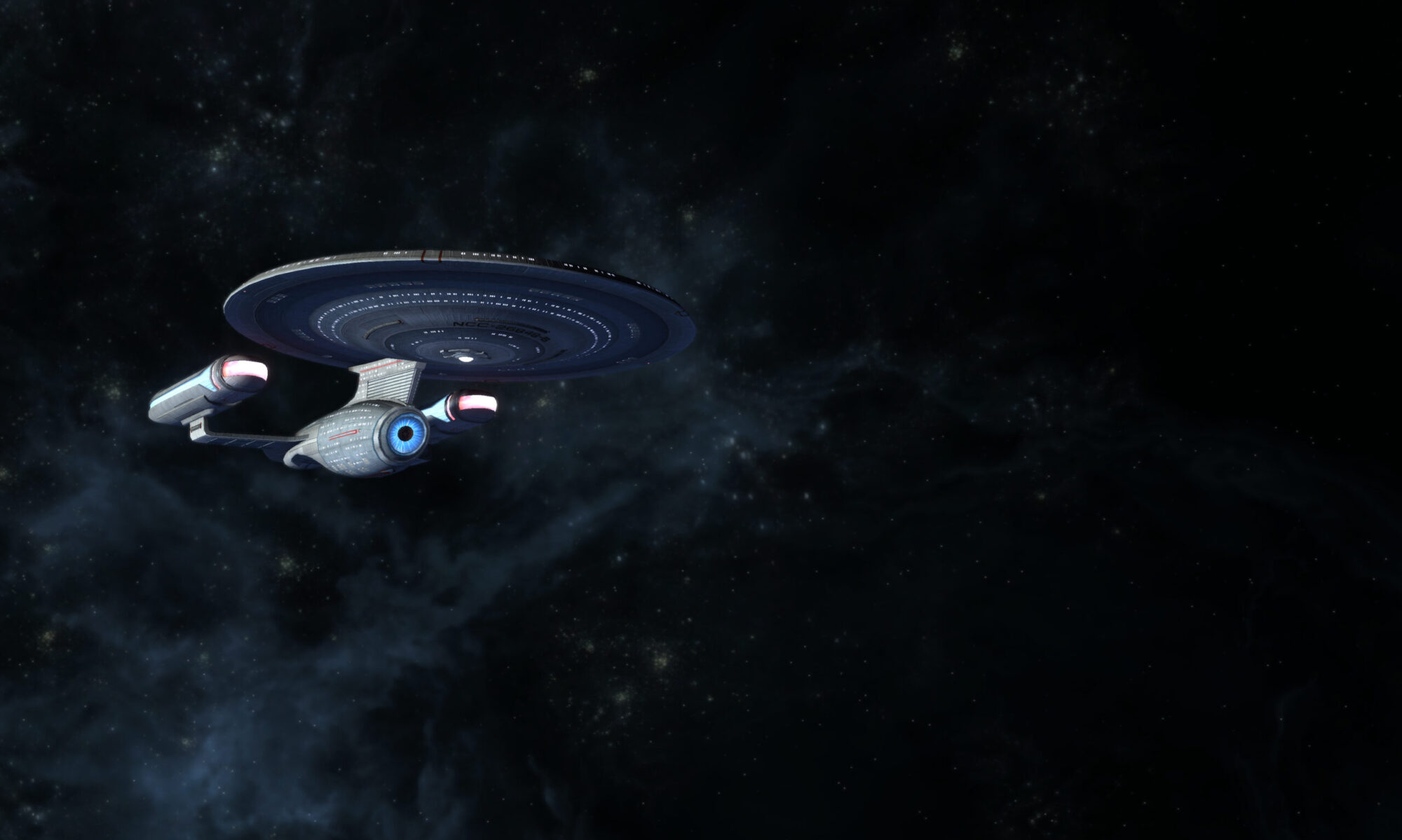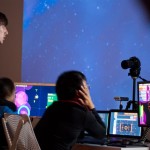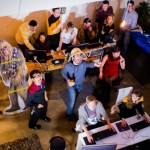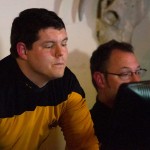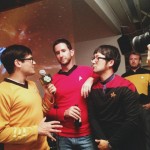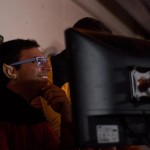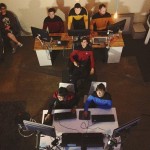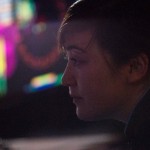Away Team Report: (2012.0805) The Mars Curiosity Rover Landing at Chabot Space and Science Center

[Above: Two observatory telescopes at Chabot Space and Science Center]
On August 5th, 2012, the USS Loma Prieta beamed down a five person away team to the Chabot Space and Science Center. Our mission was to witness NASA’s historical landing of the Curiosity Mars Rover in the Center’s Planetarium holodeck. We arrived early and quickly learned that we were in for much more than we bargained for.

[Above: LT Dolgoff mans the Apollo Lunar Landing simulator]
While searching for LtCmdr Hesser, Ensign Smith and Ensign Sherry, Lt Dolgoff and I were immediately side-tracked by an Apollo lunar lander simulator housed inside a replica of an actual Apollo cockpit. After several disaster landing attempts, the rest of the away team spotted us and we continued our exploration of the facilities together. The team took turns photographing each other inside the cockpit a full size Mercury space capsule replica, trying on space helmets, examining the Center’s many telescopes, and exploring the Bill Nye Climate Lab.

[LT Dolgoff, EN Sherry and EN Smith aboard the Mars spacecraft]
Just when we thought we had expended all our options and were ready to get planetarium seats early for the Mars landing, Ensign Sherry discovered a mysterious room marked ‘air lock’. Like a good red-shirt, Ensign Sherry stepped inside the dark cylindrical room and shut the door. Much to our surprise, he emerged a moment later, alive and with a very exciting report to make. He had just been transported onto a spacecraft headed straight for Mars!
As the entire away team stepped into the mysterious room, we were seemingly transported into the interior of a manned NASA space craft on a scientific mission to mars. The hexagonal ship interior was packed full of scientific stations along the walls, as well as navigation consoles, communications equipment and a medical bay. The ‘mission director’ greeted us as we entered and ushered us to stations. The crew took turns trying to collect martian rock samples, analyzing radioactive material in isolation bays without contaminating the rest of the ship (with very little success), navigating the craft to Olympus Mons, and at one point LtCmdr Hesser and I were even trapped in the airlock’s clean-room.

[Above: EN Smith contains a radiation leak]

[Above: CAPT Perkins at a science console]

[Above: CAPT Perkins and LTCMDR Hesser share Spock’s Wrath of Khan fate]
Having completed our own simulated Mars mission in the nick of time, we quickly ran to get seats in the planetarium, only minutes before Curiosity began its complex descent onto the Martian surface. The “Seven Minutes of Terror” went by without a hitch, and only minutes after making a perfect landing, the crowd at Chabot Space and Science Center celebrated along with the JPL team as Curiosity’s first images of Mars were beamed back.
~Capt. Zach Perkins
Commanding Officer
USS Loma Prieta
Starfleet, Region 4

[Above: Success at JPL! via NASA.tv]
Away Team Crew Manifest:
CAPT Zach Perkins
LT CMDR Tom Hesser
LT Samantha Dolgoff
EN Andy Smith
EN Eden Sherry
Away Team Report: (2012.0723) TNG Remastered in the Theaters!

For most of us, it was a once in a lifetime event. Not only to see Star Trek: The Next Generation on the big screen, but to see it in all its high definition glory – the way it was meant to be when it was originally shot on 35mm film in 1987.
The USS Loma Prieta had an excellent turn out for our away mission. Our huge away team consisted of 14 crew members, and nearly everyone was in uniform! We actually weren’t the only ones in costume either, and spotted plenty of Trek themed t-shirts and even a tastefully done season one uniform skirt. The theater was sold out and packed to the gills, but the Loma Prieta away team managed to secure seats for our entire crew to sit together. There’s nothing like the sight of an entire movie theater row of Trekkies in uniform!
We were first greeted by a TNG trivia quiz on screen, which was laughably easy for any card carrying Trekkie. But when the lights dimmed, the projection started, and the familiar planetary bodies of the TNG opening credits came into view, the experience was breathtaking and other worldly. It doesn’t matter how many times you’ve seen the Enterprise-D roll on screen or heard Patrick Stewart recite those famous lines – NOTHING compares to seeing it on the big screen!
Before and between episodes, the crowd was entertained by some never before seen behind the scenes footage, a documentary about the impressive undertaking required to remaster a show like TNG, and best of all some hilarious and revealing casting footage from the pre-production of TNG. If you haven’t seen the ‘Geordi jheri curl’ picture yet, Google it asap – it’s breathtakingly awesome.
The TNG Remastered screening was possibly my favorite movie screening experience to date (I still have the bad taste in my mouth from the Star Wars prequel premieres ), and proved to be an excellent recruitment tool for our chapter. Since then, we’ve added 5 new STARFLEET registered crew members! Why can’t they screen TNG episodes like this every week??
~Capt. Zach Perkins
Commanding Officer
USS Loma Prieta
Starfleet, Region 4

Away Team Crew Manifest:
CAPT Zach Perkins
CMDR Jon Sung
LT CMDR Tom Hesser
CAPT Erik Roberts
LT JG Ben Roodman
LT JG Jesse MacKinnon
CPO Tria Connell
EN Andy Smith
EN Amy Sloan
EN Chef Spencer Scott
EN Tiffany Bukowski
EN Shawn Alpay
EN Nick Leonard
Crewman Robert Barton
EN Eden Sherry (not pictured)
Historical Analysis (2012.0731): The Cultural and Commercial Origins of Star Trek

The people who turned their television sets to NBC at 8:30pm on Thursday, September 8, 1966 were greeted with a show that flummoxed the critics, the censors, and even the network that was airing it. But the younger generation, coming of age in a time of cultural revolution, took this genre-defining television show to heart. While it conveyed messages that some of the old guard were unprepared for, it did not come to fruition in a cultural vacuum. Star Trek was the aesthetic product of a long literary tradition, other film and television, and of 1960s social politics—all reappropriated to send Captain Kirk and his crew where no man had gone before.
Star Trek’s distant ancestors arose with the adventure novel. Jonathan Swift’s Captain Gulliver traversed a decidedly fantasy world, populated with giants, homonculi and immortals. Political satire was the most important component of these tales, as the fantasy served as a direct metaphor for contemporaneous political events. Science Fiction took an important early turn with Jules Verne’s 20,000 Leagues Under the Sea, which cemented the role of naval parlance within Science Fiction. Indeed, later writers took direct inspiration from the iconography of the Nautilus, placing similar tales of adventure in outer space.
These literary trends were galvanized with the Golden Age of Science Fiction. Amongst these were colorful action-adventure stories of interstellar conflict, often directed at children. They were further distilled in 1941, when Wilson Tucker proposed “space opera” as the appropriate term for the “hacky, grinding, stinking, outworn, spaceship yarn.” Although the term was originally pejorative, it is now frequently used with nostalgic affection, applying to large scale space adventure stories.
During the 1940s some of the naive charm of literary space opera was lost as standards of writing rose. Plots became more complicated, and the trend shifted towards a more vivid and lush romanticism. Most notable were the works of A.E. van Vogt, a master of intricate, metaphysical space opera. His tales were populated with the monsters, time paradoxes and quasimessianic supermen which would later inform Star Trek. Yet van Vogt was hardly the sole influence from this period that Trek would later draw from. The canon of Robert Heinlein contrasted militaristic themes and a free sex attitude. And by the time Isaac Asimov wrote his Foundation series using the theme of the “Galactic Empire,” the impression of vast scale so important to space opera was no longer the sole prerogative of straightforward adventure stories; it could now be used in a more serious context.
As Science Fiction literature was experiencing its Renaissance, it found an explosion of creativity in the medium of film. At the apogee of this trend was Forbidden Planet, which served as the text that most directly influenced Star Trek. In this adaptation of Shakespeare’s The Tempest, a regimented, military space vessel filled with male crewmen visits a planet; they encounter an unstable scientist; the captain romances his daughter; and in the end the narrative communicates an existential lesson. The plot, mixing the tawdry and the potent, is very sophisticated for its time—astonishingly so for a film ostensibly designed for a juvenile audience.
Television’s contribution to the genre of science fiction was largely postponed until the beginning of the 1960s. What the small screen did offer were serials that parroted Flash Gordon and Buck Rogers. From Captain Video to Space Patrol, these kiddie serials were lacking in storytelling and character development. To be sure, the spirit of these entries in the genre continued with the collected works of Irwin Allen; yet they were eclipsed by a more mature piece of television programming.
American science fiction television changed forever in 1959. The Twilight Zone, the half-hour CBS series hosted by Rod Serling (with his trademark cigarette, thin black tie and rasping voice) was perhaps the most famous anthology series to ever grace television. Though most of the episodes were pure Fantasy, a number of them were science fiction, including the pilot episode “Where is Everybody?” Soon after, ABC premiered The Outer Limits, their hour long answer to the speculative fiction anthology format. Though leaning more towards the monster-movie end of the science fiction spectrum, the series was often innovative in both style and subject matter; indeed, many of its writers were literary science fiction professionals and expanded the conventions of the genre.
These circumstances led Desilu and NBC to investigate the possibility of a new series. The space opera serial was a proven television format, albeit for a younger audience; and the speculative fiction anthology had proven to be moderately successful at rival networks. Therefore writer Gene Roddenberry’s pitch for Star Trek operated as a nexus between two successful genres: the iconography and conventions of the kiddie space shows, and the format of the anthology programs. The spaceship would travel to a new planet each week and find a different array of challenges.
Roddenberry had pitched his show as “Wagon Train to the Stars,” expounding on the dearth of Westerns currently enjoying wild success on television. These shows drew on a diverse literary tradition. The ideology they espoused had found perfect expression in Fredrick Jackson Turner’s Frontier thesis, which optimistically viewed society as an organism evolving inexorably from “simple” to “complex.” While this characterization is ultimately an inadequate representation of profound transformations, several of the important films of the Western genre—notably Howard Hawks’ Red River and George Stevens’ Shane—propagated an erroneous perception of land on the Frontier and its “evolving” use, namely in their presentation of it as an unspoiled wilderness.
This American folklore was concurrently being redeployed in American politics, this time to serve a moderately liberal agenda. In 1960, John F. Kennedy stated that “We stand on the edge of a New Frontier—the frontier of unfulfilled hopes and dreams, a frontier of unknown opportunities and beliefs in peril. Beyond that frontier are uncharted areas of science and space, unsolved problems of peace and war, unconquered problems of ignorance and prejudice, unanswered questions of poverty and surplus.” In the minds of its creators, Star Trek would represent the natural fulfillment of Kennedy’s promises centuries hence; what would be termed “The Final Frontier.”
Of course, NBC and Desilu remained for-profit corporations more interested in pleasing stockholders and advertisers than communicating any overtly political message. Yet Kennedy’s message was not a radical proposal; the “New Frontier” represented a moderate strain of American political thought. And with the passage of the Civil Rights Act of 1964, progressive trends of inclusivity were codified in American law and began to work their way into the cultural mainstream. Therefore there was enough advertiser interest in a series that would cater to a broad audience, with special appeal to a youth demographic. And if the political talk remained coded and within the larger pluralist center, all the better.
Helm Officer
USS Loma Prieta
Starfleet, Region 4
Captain’s Blog: (2012.0722) “When Looking To The Stars, Keep Both Eyes Open”
 It’s been far too long since I made a formal entry into the Captain’s (b)log. Since April, we’ve continued our regular pace of holding at least one crew meeting and one away mission per month. We’ve conducted regular tactical ARTEMIS bridge simulations, had remastered TNG screenings, held a Star Trek board game night, went on a trip to the Maker Faire Bay Area, had a Prometheus opening weekend screening, a STARFLEET Academy study night, and even witnessed the 75th Anniversary of the Golden Gate Bridge. In April, Ensign Robert Schaefer once again updated our ship’s logo, this time in full glorious LCARs color! Ensign Thomas Marrone also created a new logo for Region 4, and while it was well received by many chapters, in June the COs took a vote and ultimately decided to stick with the old logo. But as they say – “change is like an iceberg. It might be slow, but it can’t be stopped”. In May, the crew successfully launched the Federation Aid for Developing Worlds program. Using KIVA Micro-Loans, the USS Loma Prieta contributed $100 to a family in Uganda to finish their home and buy the supplies they needed to start a maize business in their community. In six months, the crew will select a new recipient for Federation Aid in a different sector of the Galaxy.
It’s been far too long since I made a formal entry into the Captain’s (b)log. Since April, we’ve continued our regular pace of holding at least one crew meeting and one away mission per month. We’ve conducted regular tactical ARTEMIS bridge simulations, had remastered TNG screenings, held a Star Trek board game night, went on a trip to the Maker Faire Bay Area, had a Prometheus opening weekend screening, a STARFLEET Academy study night, and even witnessed the 75th Anniversary of the Golden Gate Bridge. In April, Ensign Robert Schaefer once again updated our ship’s logo, this time in full glorious LCARs color! Ensign Thomas Marrone also created a new logo for Region 4, and while it was well received by many chapters, in June the COs took a vote and ultimately decided to stick with the old logo. But as they say – “change is like an iceberg. It might be slow, but it can’t be stopped”. In May, the crew successfully launched the Federation Aid for Developing Worlds program. Using KIVA Micro-Loans, the USS Loma Prieta contributed $100 to a family in Uganda to finish their home and buy the supplies they needed to start a maize business in their community. In six months, the crew will select a new recipient for Federation Aid in a different sector of the Galaxy.  The last few months have also been an exciting time for the Stellar Cartography department. In addition to viewing the transit of Venus across the Sun using special solar sensors, Lt(jg) Ben Roodman and Ensign Shawn Alpay have started the USS Loma Prieta’s ‘SETI @ Home’ team. Through the use of BOINC software, we’ve donated our computers’ spare processing time to analyze radio signals received from space and aid the scientific community’s search for extraterrestrial life. In less than two weeks, our small team has risen from the very bottom up to the 40th percentile of US based SETI teams. As Captain, I’ve had a few personal achievements as well. The comedy podcast ‘Improvised Star Trek’ recorded not one but two of my episode title suggestions, “Hell’s Nacelles” (out soon) and “The Postman Always Hails Twice” (available now). As Region 4 Social Media Director I’ve been working to revamp the Digital Shakedown Certification program, starting by working with a Region 4 shakedown vessel in Arizona, the USS Leonidas. Also, in conjunction with STARFLEET Medical, I took over as Chief of SFI Fire-Rescue, which will soon create a cadre of Emergency Response Teams (ERTs) made up of STARFLEET Paramedics, Damage Control, and Rescue officers. Since launching, our pace and ambition has been relentless. With remastered TNG movie theater screenings, astronomy based away missions, and ship vs ship ARTEMIS battles on the horizon, there are no signs of us letting up. Now more than ever we must bear in mind our ship’s motto – “When looking to the stars, keep both eyes open.” ~Capt. Zach Perkins Commanding Officer USS Loma Prieta Starfleet, Region 4
The last few months have also been an exciting time for the Stellar Cartography department. In addition to viewing the transit of Venus across the Sun using special solar sensors, Lt(jg) Ben Roodman and Ensign Shawn Alpay have started the USS Loma Prieta’s ‘SETI @ Home’ team. Through the use of BOINC software, we’ve donated our computers’ spare processing time to analyze radio signals received from space and aid the scientific community’s search for extraterrestrial life. In less than two weeks, our small team has risen from the very bottom up to the 40th percentile of US based SETI teams. As Captain, I’ve had a few personal achievements as well. The comedy podcast ‘Improvised Star Trek’ recorded not one but two of my episode title suggestions, “Hell’s Nacelles” (out soon) and “The Postman Always Hails Twice” (available now). As Region 4 Social Media Director I’ve been working to revamp the Digital Shakedown Certification program, starting by working with a Region 4 shakedown vessel in Arizona, the USS Leonidas. Also, in conjunction with STARFLEET Medical, I took over as Chief of SFI Fire-Rescue, which will soon create a cadre of Emergency Response Teams (ERTs) made up of STARFLEET Paramedics, Damage Control, and Rescue officers. Since launching, our pace and ambition has been relentless. With remastered TNG movie theater screenings, astronomy based away missions, and ship vs ship ARTEMIS battles on the horizon, there are no signs of us letting up. Now more than ever we must bear in mind our ship’s motto – “When looking to the stars, keep both eyes open.” ~Capt. Zach Perkins Commanding Officer USS Loma Prieta Starfleet, Region 4
